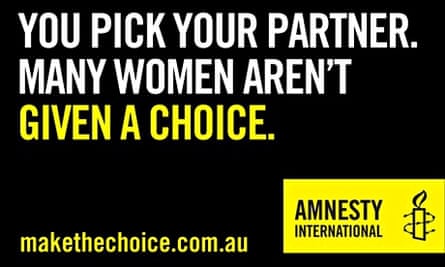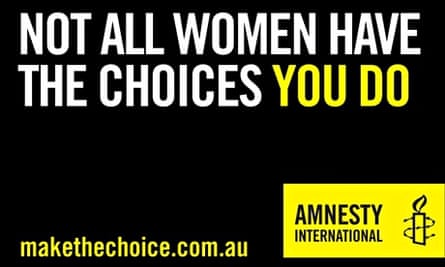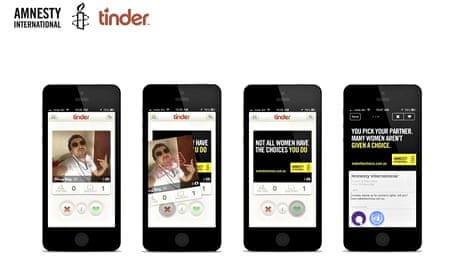In case you didn't know, Tinder is one of the latest social trends among 18 to 34 year olds. It's a dating app where singles upload profile pictures via their Facebook account and use the app to swipe through partner options. As a picture pops up, you swipe to the left to reject, or right for a yes. If your yes swipes to the right too, you've got a match and you can start messaging.
The idea
So what does any of this have to do with an international human rights organisation? In March, Amnesty ran a Tinder Takeover – to highlight women's rights. In the place of profile pictures, Amnesty shared downloadable images with statements to illustrate how life choices are not an option for many women around the world.
The idea came from creative agency Circul8 in response to our brief requesting a 'digital interactive engagement tool', targeting a youth-based audience, to draw attention to Amnesty's work on women's rights in places like Afghanistan, Mexico, Saudi Arabia.
The campaign was centred around International Women's Day with the Tinder images that Amnesty posted driving traffic to the Make a choice website. Here, we ran a quiz in which users were asked to make choices like marry for money or marry for love.
A click on money revealed a new page that explained that in rural Pakistan many girls are sold into forced marriage. Data, including email addresses was captured on the site, and interested visitors were contacted to see if they would like to support Amnesty's human rights work.

What needs to be considered when using new channels?
Social media is evolving all the time, so in order to keep pace and be innovative, while keeping costs down, it pays to be willing to take chances. Tinder is very underdeveloped as a marketing tool, but it offers engagement with an audience that we don't often capture the attention of.
As it wasn't a traditional medium and is very much powered by the people, we had to be prepared to roll our sleeves up to make an impact, so it was all hands on deck to make it happen. That meant recruiting supporters and activists in different states to join our Tinder takeover.
Through our website and Facebook page, we asked the public to log on to Tinder on International Women's Day, upload Amnesty's images as their profile pictures and encourage others to visit the Make a change website in their about me section.
On the day Tinder prioritised Amnesty's profile meaning it would feature on more user's screens. When users logged on to the app they saw profile pictures displaying messages such as, "Not all women have the power to choose like you do" and "You pick your partner. Many women aren't given the choice."
Despite not being able to track the exact number of participants, Amnesty International had thousands more click-throughs to their website and members signed up in their hundreds.
Content clues
Tinder only operates in a mobile environment compared to the channels fundraisers like myself often use. We were mindful that we were talking to individuals in leisure mode and we were also wary that Amnesty's messaging could come across as 'too serious' in such a relaxed medium. But for us, taking the chance was about generating new leads, getting users to share our messages and creating a buzz around our work on women's rights.

Be creative
We went out with an open brief and were prepared to take a risk. Circul8 delivered a really original concept. We certainly learnt through this successful experiment: if you want innovation you need to provide and leave room for creativity.
We did seek approval from Tinder to launch the takeover, and they were very supportive of the idea, but the main point is that while it was our concept, the success of this partnership came down to all the people from inside and outside of Amnesty International that got behind it and made the choice to takeover Tinder. The combined message was that everyone, regardless of their gender, has the right to decide: yes or no.
Caroline Easter is a supporter acquisition manager at Amnesty International Australia.
For more news, opinions and ideas about the voluntary sector, join our community – it's free!



Comments (…)
Sign in or create your Guardian account to join the discussion